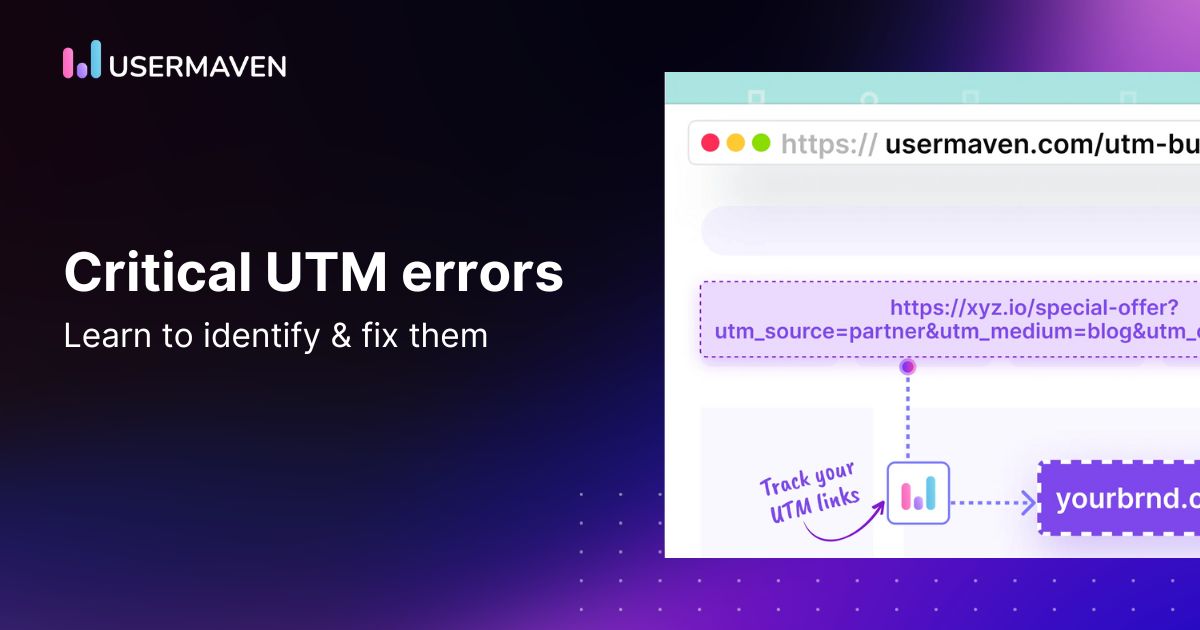Urchin Tracking Modules, or UTMs for short, are super important for anyone doing marketing. They’re these bits of info you tack onto the end of website links to see where visitors come from and how well your ads and stuff are working. But even though they’re handy, it’s easy to mess up with UTM tracking. Knowing what mistakes to avoid can really make a difference. By getting it right, you’ll get valuable data that helps your marketing efforts big time by showing you exactly how traffic gets to your site and which campaigns hit the mark.
At Usermaven, we’ve seen firsthand how common UTM mistakes can impact marketing analytics. That’s why we’ve developed our robust UTM Builder to help marketers avoid these pitfalls. In this comprehensive guide, we’ll explore ten critical UTM parameter mistakes and show you how to sidestep them.

Why are UTM parameters crucial for analytics?
UTM parameters are super important for figuring out where all the visitors to a website come from and how well different marketing efforts are doing. When marketers use UTM tracking, they can really see which ways of advertising, like social media or email campaigns, bring in the most people and lead to actions like sales.
Without these codes, it’s tough to know exactly which ad or email made someone visit your site. By putting UTM tracking into action, marketers get their hands on useful info that helps them tweak their ads better so they can make more money from what they spend.
In essence:
- With UTM parameters, understanding where website traffic comes from gets much clearer.
- They help show which marketing channels and specific campaigns work best.
- Using this approach provides valuable insights into improving future marketing moves.
- It makes sure every dollar spent on marketing is worth it by showing what brings real results.
10 common UTM mistakes and how to fix them
1. Using UTM tracking when you shouldn’t
One of the most dangerous UTM mistakes is using tracking codes where they’re not needed or even counterproductive. This often happens when marketers add UTM parameters to internal links on their websites.
Why it’s a problem:
- Tracking tools like Usermaven already track visitor activity as they navigate your site.
- Adding UTM parameters to internal links erases information about the original traffic source.
Example: A visitor comes to your blog from Twitter. They read your article and click on an internal link to a product page. If that internal link has UTM parameters, you’ll lose the valuable information that the visitor originally came from Twitter.
How to avoid it: Reserve UTM tracking for external links, such as:
- Email client links
- Links in documents (PDF, MS Word, PowerPoint)
- Mobile app links
- Social media platform links
Usermaven’s UTM Builder helps you focus on creating UTM codes for the right scenarios, ensuring you’re not overcomplicating your internal tracking.
2. Failing to shorten long, messy URLs
UTM parameters can make your URLs long and unwieldy. This isn’t just an aesthetic issue; it can actually impact your marketing effectiveness.
Why it’s a problem:
- Long URLs look unappealing and can decrease click-through rates.
- They can create suspicion and distrust among potential visitors.
- They’re difficult to use on character-limited platforms like Twitter.
Example of a messy URL:
https://www.yourwebsite.com/landing-page/?utm_source=newsletter&utm_medium=email&utm_campaign=summer_sale_2024&utm_content=hero_image&utm_term=discount_shoesHow to fix it:
This is where Replug’s link shortener comes to the rescue. It allows you to create clean, branded short URLs that are both user-friendly and trackable.
Shortened version:
https://repl.ug/summer24
Using Replug’s link shortener with Usermaven’s UTM Builder gives you the best of both worlds: comprehensive tracking and clean, professional-looking links.
Also read: Cracking meta-threads analytics with UTM traffic
3. Confusing medium and source parameters
The difference between utm_medium and utm_source is a common source of confusion for many marketers.
Why it’s a problem:
Mixing up these parameters leads to inaccurate data and makes it difficult to properly analyze your marketing efforts.
How to remember the difference:
- utm_medium: How the visitor came to your website (e.g., email, social, cpc)
- utm_source: Where the visitor came from (e.g., newsletter, twitter, google)
Incorrect example:
utm_medium=facebook&utm_source=social
Correct example:
utm_medium=social&utm_source=facebook
Also read: What is social traffic in digital analytics?
4. Failing to use the campaign parameter effectively
The utm_campaign parameter gives you the flexibility to analyze your marketing efforts by specific business objectives. However, many marketers use it ineffectively with generic or forgettable labels.
Why it’s a problem:
- Generic campaign names make it difficult to recall specific campaigns when analyzing data later.
- It becomes challenging to compare different campaigns effectively.
Ineffective examples:
utm_campaign=email_29 utm_campaign=social_post
Effective examples:
utm_campaign=summer2024_launch utm_campaign=weekly_newsletter_2024_06_15
5. Lack of consistency in spelling, capitalization, and naming conventions
UTM parameters are case-sensitive, and even slight variations can fragment your data.
Why it’s a problem:
- Inconsistencies create multiple data segments instead of a single, comprehensive view.
- Analyzing campaign performance becomes time-consuming and error-prone.
Inconsistent examples:
utm_source=Email utm_source=email utm_source=E-mail
Consistent example:
utm_source=email
Also read: 10 must-have marketing attribution tools for 2024
6. Creating new campaign names for every different medium and source
Many marketers create new campaign names for each channel, missing the bigger picture of multi-channel campaigns.
Why it’s a problem:
- It becomes difficult to see how different channels work together in a single campaign.
- You miss out on valuable insights about the overall effectiveness of your marketing efforts.
Incorrect approach:
utm_campaign=twitter_summer_launch utm_campaign=facebook_summer_launch utm_campaign=email_summer_launch
Correct approach: Use a single campaign name across all channels:
utm_campaign=summer_launch_2024
Then use utm_source and utm_medium to differentiate channels:
utm_campaign=summer_launch_2024&utm_source=twitter&utm_medium=social
utm_campaign=summer_launch_2024&utm_source=facebook&utm_medium=social
utm_campaign=summer_launch_2024&utm_source=newsletter&utm_medium=email
Usermaven’s UTM Builder allows you to create campaign templates, making it easy to maintain consistency across multiple channels while still tracking individual sources and mediums.
7. Forgetting to add UTM tags to all links in a campaign
It’s easy to overlook some links when tagging, especially in larger campaigns.
Why it’s a problem:
- Incomplete tagging leads to partial data, making it impossible to see the full picture of your campaign’s performance.
- You might underestimate the effectiveness of certain channels or content pieces.
How to avoid it:
- Create a checklist of all links that need tagging for each campaign.
- Use Usermaven’s UTM Builder to quickly generate tags for all your campaign links at once.
Also read: 9 powerful Google Analytics alternatives (GA4 alternatives)
8. Not testing UTM tags before launching a campaign
Launching a campaign without testing your UTM tags can lead to data loss and wasted resources.
Why it’s a problem:
- Incorrect tags might not track properly, resulting in missing or inaccurate data.
- Fixing tags after a campaign has launched can be complicated and may result in incomplete data.
How to avoid it:
- Always test your tagged URLs before launching a campaign.
- Use Usermaven’s UTM Builder’s testing feature to verify your tags are working correctly.
9. Using special characters or spaces in UTM parameters
Special characters and spaces in UTM parameters can break your tracking or cause inconsistencies.
Why it’s a problem:
- Some systems may not properly interpret special characters, leading to tracking errors.
- Spaces can be interpreted differently by various systems, potentially breaking your URLs.
Incorrect examples:
utm_campaign=Summer Sale! utm_content=50% Off
Correct examples:
utm_campaign=summer_sale utm_content=50_percent_off
Usermaven’s UTM Builder automatically replaces spaces with underscores and removes special characters, ensuring your UTM parameters are always properly formatted.
Also read: 12 Strategies to increase your customer engagement
10. Not keeping UTM tags up-to-date
Marketing campaigns evolve, but UTM tags often don’t keep up.
Why it’s a problem:
- Outdated tags can lead to inaccurate reporting and confusion in data analysis.
- You might miss out on tracking new aspects of your evolving campaigns.
How to avoid it:
- Regularly review and update your UTM tags.
- Use Usermaven’s UTM management system to easily edit and update existing tags as your campaigns evolve.
Also read: Guide to tracking website visitors & top 6 tools for 2023
Usermaven UTM builder
Advantages
- Simplified UTM creation: Streamlines the process of creating UTM parameters, making it easier for marketers to implement accurate tracking.
- Improved campaign management: Enables effective monitoring and management of marketing campaigns through precise UTM implementation.
- Enhanced data insights: Provides valuable data on campaign performance, including click-through rates and conversion rates.
- Customizable reporting: Offers flexible reporting options to analyze campaign success and identify areas for improvement.
- In-depth analytics: Delivers comprehensive data to optimize marketing strategies and maximize ROI.
- Time-saving: Reduces the time spent on manual UTM creation and management.
- Increased efficiency: Helps marketers focus on strategic planning rather than technical implementation.

How can you track UTM traffic with Usermaven?
To track UTM traffic with Usermaven, follow these steps:
- Create UTM parameters: Add UTM parameters to your URLs to track the source, medium, and campaign.
- Set up tracking: Ensure your website is integrated with Usermaven by installing the tracking code.
- Monitor traffic: Use Usermaven’s analytics dashboard to monitor traffic coming from your UTM-tagged URLs. Usermaven will show you detailed insights about the performance of your campaigns based on the UTM parameters.
Conclusion
UTM tracking is a great way to make your analytics better, but it’s easy to mess up. Mistakes like using too many details or not keeping things consistent can mess with how accurate your data is. To keep track of everything correctly, you should be clear about where your traffic comes from and how it gets there, stick to the same way of labeling things, and try not to complicate your web addresses too much.
Checking on this regularly and using tools designed for UTM tracking, such as Usermaven, are important steps toward getting better at this. By steering clear of these common errors, you’ll improve how you analyze data and get valuable insights into what works in your campaigns.
Try Usermaven’s UTM Builder today and see the difference clear, consistent UTM tracking can make in your campaigns!

FAQs
1. What are UTM parameters?
UTM parameters are tags added to the end of a URL to track the effectiveness of online marketing campaigns across different traffic sources.
2. What are the most common UTM mistakes marketers make?
The most common UTM mistakes include inconsistent naming conventions, using incorrect or incomplete parameters, not using UTM tracking at all, and failing to clean up old or irrelevant UTM codes. These errors can lead to inaccurate data and misleading analytics reports.
3. What is the best way to manage UTM parameters for accurate tracking?
The best way to manage UTM parameters is to establish a standardized naming convention, maintain a centralized document for all UTM tags, and regularly audit your links to ensure consistency.
4. How can I avoid UTM mistakes when creating new campaigns?
To avoid UTM mistakes, follow these best practices: establish clear naming conventions, use a UTM builder tool, regularly audit your UTM links, and educate your marketing team about proper UTM usage.
5. How often should I audit my UTM parameters for accuracy?
It’s recommended to audit your UTM parameters regularly, at least once a quarter, or whenever launching a new campaign.
6. What tools can help with managing and tracking UTM parameters?
Several tools can help manage and track UTM parameters. Use our free UTM builder tool to ensure accurate tracking.

Leave a Reply